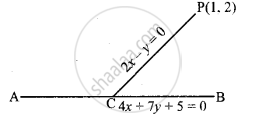Advertisements
Advertisements
Question
Find the distance of the line 4x + 7y + 5 = 0 from the point (1, 2) along the line 2x – y = 0.
Solution
Let the equation of line PC be 2x – y = 0 on which point P(1, 2) lies.

On solving the equation of line AB 4x + 7y + 5 = 0 and 2x – y = 0,
∴ x = `(-5)/18`
and y = `-5/9`
∴ The coordinates of C are `((-5)/18, (-5)/9)` which is the intersection point and the coordinates of P are (1, 2).
Required length PC = `sqrt((-5/18 - 1)^2 + ((-5)/9 - 2)^2)`
= `sqrt(((-23)/18)^2 + ((-23)/9)^2)`
= `23/9 sqrt((1/2)^2 + 1)`
= `23/9 xx sqrt5/2`
= `(23sqrt5)/18`
APPEARS IN
RELATED QUESTIONS
If the lines `(x-1)/2=(y+1)/3=(z-1)/4 ` and `(x-3)/1=(y-k)/2=z/1` intersect each other then find value of k
Find the distance between parallel lines:
15x + 8y – 34 = 0 and 15x + 8y + 31 = 0
Find the distance between parallel lines l (x + y) + p = 0 and l (x + y) – r = 0
What are the points on the y-axis whose distance from the line `x/3 + y/4 = 1` is 4 units.
If sum of the perpendicular distances of a variable point P (x, y) from the lines x + y – 5 = 0 and 3x – 2y+ 7 = 0 is always 10. Show that P must move on a line.
A line passes through a point A (1, 2) and makes an angle of 60° with the x-axis and intersects the line x + y = 6 at the point P. Find AP.
Find the distance of the point (2, 5) from the line 3x + y + 4 = 0 measured parallel to the line 3x − 4y+ 8 = 0.
The perpendicular distance of a line from the origin is 5 units and its slope is − 1. Find the equation of the line.
Find the perpendicular distance of the line joining the points (cos θ, sin θ) and (cos ϕ, sin ϕ) from the origin.
Show that the path of a moving point such that its distances from two lines 3x − 2y = 5 and 3x + 2y = 5 are equal is a straight line.
If sum of perpendicular distances of a variable point P (x, y) from the lines x + y − 5 = 0 and 3x − 2y + 7 = 0 is always 10. Show that P must move on a line.
Determine the distance between the pair of parallel lines:
8x + 15y − 34 = 0 and 8x + 15y + 31 = 0
Determine the distance between the pair of parallel lines:
y = mx + c and y = mx + d
Determine the distance between the pair of parallel lines:
4x + 3y − 11 = 0 and 8x + 6y = 15
Find the equation of two straight lines which are parallel to x + 7y + 2 = 0 and at unit distance from the point (1, −1).
Answer 3:
Prove that the lines 2x + 3y = 19 and 2x + 3y + 7 = 0 are equidistant from the line 2x + 3y= 6.
If the centroid of a triangle formed by the points (0, 0), (cos θ, sin θ) and (sin θ, − cos θ) lies on the line y = 2x, then write the value of tan θ.
If the lines x + ay + a = 0, bx + y + b = 0 and cx + cy + 1 = 0 are concurrent, then write the value of 2abc − ab − bc − ca.
Write the locus of a point the sum of whose distances from the coordinates axes is unity.
The distance between the orthocentre and circumcentre of the triangle with vertices (1, 2), (2, 1) and \[\left( \frac{3 + \sqrt{3}}{2}, \frac{3 + \sqrt{3}}{2} \right)\] is
The area of a triangle with vertices at (−4, −1), (1, 2) and (4, −3) is
The vertices of a triangle are (6, 0), (0, 6) and (6, 6). The distance between its circumcentre and centroid is
The ratio in which the line 3x + 4y + 2 = 0 divides the distance between the line 3x + 4y + 5 = 0 and 3x + 4y − 5 = 0 is
A plane passes through (1, - 2, 1) and is perpendicular to two planes 2x - 2y + z = 0 and x - y + 2z = 4. The distance of the plane from the point (1, 2, 2) is ______.
If the tangent to the curve y = 3x2 - 2x + 1 at a point Pis parallel toy = 4x + 3, the co-ordinates of P are
If P(α, β) be a point on the line 3x + y = 0 such that the point P and the point Q(1, 1) lie on either side of the line 3x = 4y + 8, then _______.
Find the distance between the lines 3x + 4y = 9 and 6x + 8y = 15.
If the sum of the distances of a moving point in a plane from the axes is 1, then find the locus of the point.
A point equidistant from the lines 4x + 3y + 10 = 0, 5x – 12y + 26 = 0 and 7x + 24y – 50 = 0 is ______.
A straight line passes through the origin O meet the parallel lines 4x + 2y = 9 and 2x + y + 6 = 0 at points P and Q respectively. Then, the point O divides the segment Q in the ratio:
